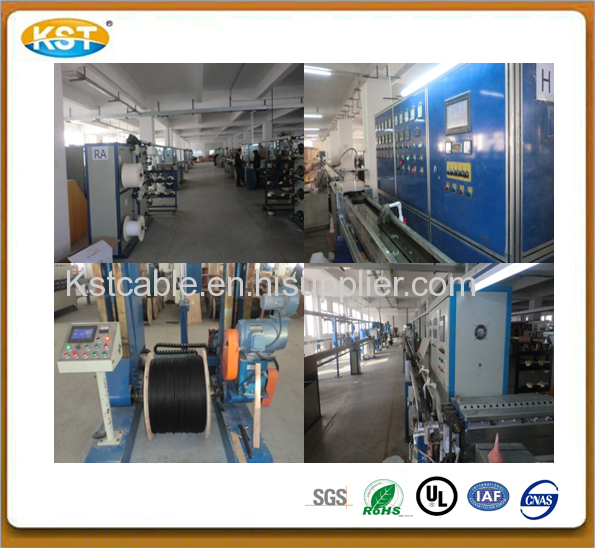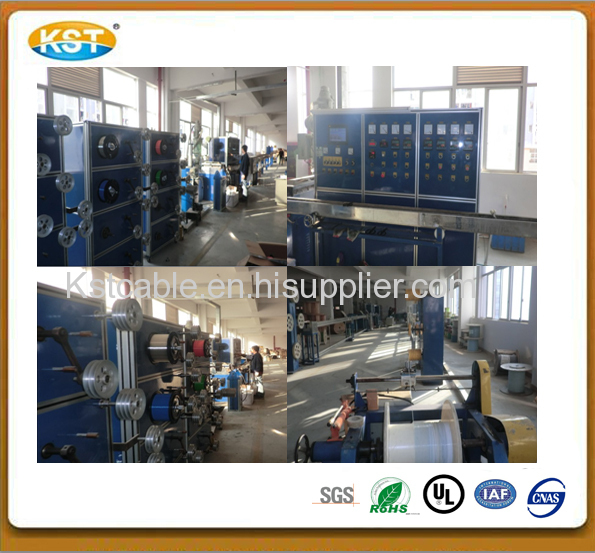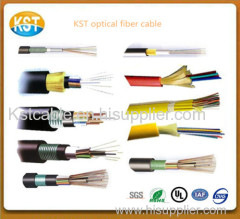Product Descriptions:
Fiber Optic Cable
Cable Types: (L>R): Zipcord, Distribution, Loose Tube, Breakout
Cable provides protection for the optical fiber or fibers within it appropriate for the environment in which it is installed.
Fiber optic "cable" refers to the complete assembly of fibers, other internal parts like buffer tubes, ripcords, stiffeners, strength members all included inside an outer protective covering called the jacket. Fiber optic cables come in lots of different types, depending on the number of fibers and how and where it will be installed. It is important to choose cable carefully as the choice will affect how easy the cable is to install, splice or terminate and what it will cost.
Cable's job is to protect the fibers from the environment encountered in an installation. Will the cable become wet or moist? Will it have to withstand high pulling tension for installation in conduit or continual tension as in aerial installations? Does it have to be flame-retardant? Ultra flexible? Will the cable be exposed to chemicals or have to withstand a wide temperature range? What about being gnawed on by a woodchuck or prairie dog? Inside buildings, cables don't have to be so strong to protect the fibers, but they have to meet all fire code provisions. Outside the building, it depends on whether the cable is buried directly, pulled in conduit, strung aerially or whatever.
All cables are comprised of layers of protection for the fibers. Most all start with standard fiber with a primary buffer coating (250 microns) and add:
Tight buffer coating (tight buffer cables like simplex, zipcord, distribution and breakout types): A soft protective coating applied directly to the 250 micron coated fiber to provide additional protection for the fiber, allowing easier handling, even direct termination on the fiber.
Cable Types
Tight buffer cables(Simplex, Zipcord, Distribution and Breakout)are used where cable flexibility and ease of termination are important, more so than ruggedness and pulling strength which characterize loose tube and ribbon types of cable. Generally, tight buffer cables are used indoors and loose tube/ribbon cables outdoors.
Simplex and zip cord:
These types areused mostly for patch cord and backplane applications, but zipcord can also be used for desktop connections.Simplex cables are one fiber, tight-buffered (coated with a 900 micron buffer over the primary buffer coating) with Kevlar (aramid fiber) strength members and jacketed for indoor use. The jacket is usually 3mm (1/8 in.) diameter. Zipcord is simply two of these joined with a thin web.
Distribution cables:
Distribution cable is the most popular indoor cable, as it is small in size and light in weight. They contain several tight-buffered fibers bundled under the same jacket with Kevlar strength members and sometimes fiberglass rod reinforcement to stiffen the cable and prevent kinking. These cables are small in size, and used for short, dry conduit runs, riser and plenum applications. The fibers are double buffered and can be directly terminated, but because their fibers are not individually reinforced, these cables need to be broken out with a "breakout box" or terminated inside a patch panel or junction box to protect individual fibers.
Breakout cables:
Breakout cable is a favorite where rugged cables are desirable or direct termination without junction boxes, patch panels or other hardware is needed. They are made of several simplex cables bundled together insdie a common jacket. This is a strong, rugged design, but is larger and more expensive than the distribution cables. It is suitable for conduit runs, riser and plenum applications. It's perfect for industrial applications where ruggedness is needed. Because each fiber is individually reinforced, this design allows for quick termination to connectors and does not require patch panels or boxes. Breakout cable can be more economic where fiber count isn't too large and distances too long, because is requires so much less labor to terminate.
Loose tube cables:
Loose tube cables are the most widely used cables for outside plant trunks because it offers the best protection for the fibers under high pulling tensions and can be easily protected from moisture with water-blocking gel or tapes.These cables are composed of several fibers together inside a small plastic tube, which are in turn wound around a central strength member, surrounded by aramid strength members and jacketed, providing a small, high fiber count cable. This type of cable is ideal for outside plant trunking applications, as it can be made with the loose tubes filled with gel or water absorbent powder to prevent harm to the fibers from water. It can be used in conduits, strung overhead or buried directly into the ground. Some outdoor cables may have double jackets with a metallic armor between them to protect from chewing by rodents or kevlar for strength to allow pulling by the jackets.Since the fibers have only a thin buffer coating, they must be carefully handled and protected to prevent damage. Loose tube cables with singlemode fibers are generally terminated by spicing pigtails onto the fibers and protecting them in a splice closure. Multimode loose tube cables can be terminated directly by installing a breakout kit, also called a furcation or fan-out kit, which sleeves each fiber for protection.
Ribbon Cable:
Ribbon cable is preferred where high fiber counts and small diameter cables are needed.This cable has the most fibers in the smallest cable, since all the fibers are laid out in rows in ribbons, typically of 12 fibers, and the ribbons are laid on top of each other. Not only is this the smallest cable for the most number of fibers, it's usually the lowest cost. Typically 144 fibers only has a cross section of about 1/4 inch or 6 mm and the jacket is only 13 mm or 1/2 inch diameter! Some cable designs use a "slotted core" with up to 6 of these 144 fiber ribbon assemblies for 864 fibers in one cable! Since it's outside plant cable, it's gel-filled for water blocking or dry water-blocked. Another advantage of ribbon cable is Mass Fusion Splicers can join a ribbon (12 fibers) at once, making installation fast and easy. Ribbon pigtails are spliced onto the cable for quick termination.
Armored Cable:
Armored cable is used in direct buried outside plant applicationswhere a rugged cable is needed and/or rodent resistance. Armored cable withstands crush loads well, needed for direct burial applications. Cable installed by direct burial in areas where rodents are a problem usually have metal armoring between two jackets to prevent rodent penetration. Another application for armored cable is in data centers, where cables are installed underfloor and one worries about the fiber cable being crushed. Armored cable is conductive, so it must be grounded properly.
Aerial cable:
Aerial cables are for outside installation on poles. They can be lashed to a messenger or another cable (common in CATV) or have metal or aramid strength members to make them self supporting. The cable shown has a steel messenger for support.It must be grounded properly.
A widely used aerial cable is optical power ground wire (OPGW) which is a high voltage distribution cable with fiber in the center. The fiber is not affected by the electrical fields and the utility installing it gets fibers for grid management and communications. This cable is usually installed on the top of high voltage towers but brought to ground level for splicing or termination.
Our advantages:
1. Professional cable manufacturer.
2. About 10 years experiences in cable industry.
3. Cooperate with 3M, TYOC,Thai telecom, Doha airport, Doha telecom,Dubai telecom, Slovenia telecom and Yeman telecom other big projects
4. Best delivery time.
5.MOQ is 1kilometer
6.Hight quality with competitive price
7.Can be customized production of fiber optic cable
8. 4. 30 years cable service life , even 60 years cable service life.
Our main export markets:
1.Eastern Europe
2.North America
3.Mid East/Africa
4.Central/South America
5.Asia
6.Western Europe
7.Australasia
KST cable Fiber Optic Cable Testing Equipment :
Item | Device name | quantity | Production Place |
1 | optical time domain reflectometer (OTDR) | 5sets | Canada EXFO Company |
2 | Fiber Polarization Mode Dispersion | 4sets | England E G&G Company(PMD440) |
3 | Fiber Dispersion ,Strain Tester | 1set | England E G&G Company(CD-400) |
4 | High Low Temperature Test Chamber | 2sets | Guangzhou China |
5 | Cable Impact Testing Machine | 1set | Beijing China |
6 | Cable Squash Tensile Testing Machine | 2sets | Beijing China |
7 | GWQV Cable Bending Tester | 1set | Beijing China |
8 | GNZV Cable Torsion Testing Machine | 1set | Beijing China |
9 | GQNV Cable Flexing Testing Machine | 1set | Beijing China |
10 | GJRV Cable Winding Testing Machine | 1set | Beijing China |
11 | GZDV Cable Vibration Testing Machine | 1set | Beijing China |
12 | Cable Water Penetration Test | 1set | Beijing China |
13 | Fusion Splicer | 1set | ERICSSON |
14 | Cable Water Penetration Test Rig | 1set | Beijing China |
Our services;
1.We are the one of biggest manufacture of fiber optic cable in China and has many years' manufacturing
and selling experience.
2.We accept OEM. The cable size and material are customized.Your own logo and own design are welcomed.
3.We will produce according to your requirement and description;
Please send us inquiry for more products info and we will give you feedback in 12 hours.
E-mail:maxuanqin@hotmail.com





















